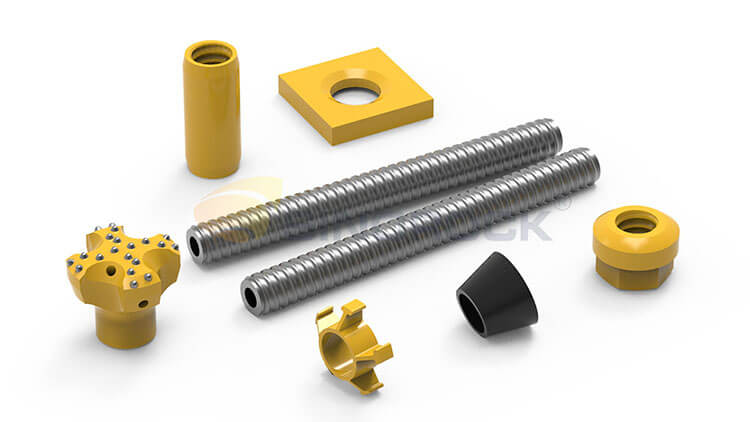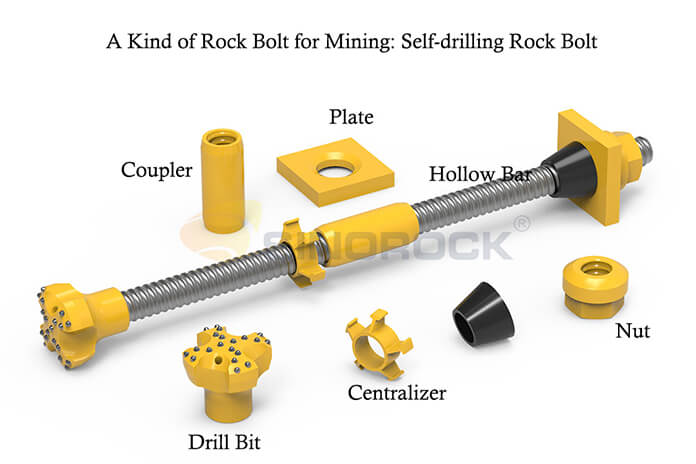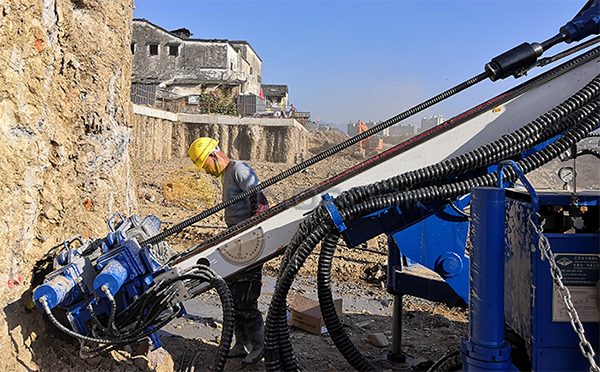What Are Self Drilling Rock Anchors?
Time:2024-01-24From:sinorock View:
I. Introduction
A. Brief explanation of the importance of rock anchors in various industries
Rock anchors play a crucial role in ensuring safety and stability in construction and excavation industries. These engineering materials are designed to support unstable formations, preventing collapses and slides in areas such as slopes, civil construction foundations, tunnels, and mining. Over the years, rock anchors have evolved to become more efficient, cost-effective, and easier to install, significantly impacting the safety standards of various projects.
B. Introduction to self-drilling rock anchors as a specific type of rock anchor
Self drilling rock anchors are also called anchor bolts, rock bolts, rock bars, and so on. They are those that can change the game rules when it comes to safety in construction and excavation industries. Developed through more than 100 years, rock anchors now can be installed more easily, lower cost, and perform well when bolting fractured rocks and soils to keep people and equipment safe. It is what self drilling rock anchors do.

II. What are self-drilling rock anchors?
A. Definition and basic concept
Self-drilling rock anchors are an advanced technique designed to support construction projects efficiently. They consist of a one-time-use drill bit, a hollow bar similar to hollow rock anchors, a coupler for extending the bar if necessary, a plate (flat or domed), a nut, and a centralizer. Unlike traditional anchors, self-drilling rock anchors combine drilling, grouting, and anchoring into a single process, making them highly convenient for challenging geological conditions.
B. Explanation of the construction and components of self-drilling rock anchors
Self-drilling rock anchors typically comprise a drill bit, hollow bar, coupler, plate, nut, and centralizer.
The crucial component of the self-drilling rock anchor is the hollow bar, which can be classified into R thread and T thread. The R-type thread is constantly corrugated, while the T-type thread is irregularly trapezoidal. The R-type thread is designed in accordance with ISO 10208 standards and is mainly used for small-diameter hollow anchor bars. On the other hand, the T-type thread is designed based on the full thread bar, featuring a deeper thread depth than the R-type and a larger bonding area with concrete. In general, the bonding friction of the same type of T-thread is more than twice that of the R-thread, and T-thread anchors are typically used in miniature piles.

In order to ensure a long-lasting and durable structure, hollow steel bars are typically manufactured from high-strength steel, which provides the necessary load-bearing capacity and longevity. When the project necessitates unparalleled durability in harsh soil environments, the hollow steel bars can be enhanced with corrosion protection via hot-dip galvanizing, or they can be entirely crafted from stainless steel, which is naturally corrosion-resistant.
To enable the self-drilling function of self-drilling rock anchors, a specifically designed drill bit at the front end is incorporated. This drill bit is typically crafted from robust materials, such as 42CrMo, etc., to withstand the high drilling forces and effectively penetrate the rock. The drill bit is equipped with cutting edges and flutes to enhance the drilling process, allowing the bolt to create its own pathway as it advances into the rock. The primary distinction between this drill bit and other rock bolt bits is its disposable design. Once the drill bit is incorporated into the hollow anchor system, it is never removed again, simplifying the replacement process and overall construction method.
C. Comparison to traditional rock anchors and their advantages
In contrast to traditional rock anchors, self-drilling rock anchors offer enhanced convenience and efficiency. The one-process approach of drilling, grouting, and anchoring streamlines installation, making it suitable for broken rocks, loose soil, and challenging geological conditions.
III. Applications and industries utilizing self-drilling rock anchors
A. Construction industry and foundation stabilization
Self-drilling rock anchors find extensive applications in the construction industry, particularly for stabilizing foundations. The article delves into how these anchors support foundations, roofs, and slopes during construction, offering a reliable and efficient solution for ensuring stability in various structural scenarios.

B. Mining industry and tunneling projects
In the mining industry, self-drilling rock anchors play a crucial role in tunneling projects. The article explores their use in fore piling, radial support, tunnel-face support, locking the foot support, and reinforcement of tunnel portals, showcasing their versatility in underground applications.

C. Slope stabilization and landslide prevention
Slope projects benefit from self-drilling rock anchors in multiple ways, including soil nail support, slope protection barriers, falling rock protection, retaining walls, embankment stability, and roadbed reinforcement. The article highlights the significance of these anchors in preventing landslides and ensuring the stability of slopes.

D. Other industries benefiting from self-drilling rock anchors
Beyond construction, mining, and slope stabilization, self-drilling rock anchors find applications in various industries. The article explores their use in new building pile foundations, existing building structure repairs, tower foundations, bridge reinforcement, soundproof wall foundations, protective screen pile foundations, anti-floating pile foundations, retaining beam anchoring, and other structural scenarios.
IV. How do self-drilling rock anchors work?
A. Anchor Selection
The process initiates with a careful assessment of project requirements, considering factors like load-bearing capacity and geological conditions. This ensures the optimal choice of self-drilling rock anchors tailored to the unique needs of the construction or excavation project.

B. Drilling Rig Operation
Utilizing a specialized drilling rig, the self-drilling rock anchor is precisely drilled into the designated location. The drill bit, designed for one-time use, plays a pivotal role in creating the necessary path for the anchor. This step is crucial for achieving the desired depth and alignment.
C. Simultaneous Grouting
Simultaneously, a grouting machine is employed to inject cement grout, the most commonly used material for self-drilling anchor injection. The water-cement ratio, typically ranging from 0.40 to 0.50, ensures optimal grout consistency. In cases requiring higher pressure, the slurry is injected under elevated pressure to fill inner rock cracks effectively.
D. Injection Monitoring
The injection process is closely monitored, and it concludes when the mixture begins to exit from the drilled hole. This meticulous monitoring ensures the thorough filling of inner rock crevices, uniting broken and loose rocks effectively.
E. Bearing Plate Placement
Subsequently, if necessary, a bearing plate is placed atop the self-drilling rock anchor. This additional component enhances stability and provides additional support, especially in scenarios where increased tension is required.
F. Tensioning the Anchor
The final step involves tensioning the self-drilling rock anchor, ensuring that it securely anchors the rocks or soil. This tensioning process is crucial for achieving the desired structural stability.
V. Benefits and advantages of self-drilling rock anchors
A. Enhanced efficiency and time-saving during installation
One of the key advantages of self-drilling rock anchors is their efficiency and time-saving benefits during installation. These rock anchors integrate drilling, grouting, and anchoring into a single process streamlining construction projects, and reducing overall installation time and labor requirements.

B. Increased load-bearing capacity compared to traditional anchors
Self-drilling rock anchors boast increased load-bearing capacity compared to traditional anchors. The adaptability of self-drilling rock anchors is highlighted in their ability to accommodate a wide range of geological conditions, especially those that are broken and complex.
C. Versatility and adaptability to different geological conditions
Self-drilling rock anchors are designed to meet the specific needs of various project requirements. The ability to tailor these rock anchors allows for their application across numerous sectors, including foundations, roofs, slopes, and underground projects. They excel in overcoming the challenges presented by rock breaks, loose soil, and complex terrains.
D. Cost-effectiveness and reduced labor requirements
Beyond labor, self-drilling rock anchors optimize resources by consolidating drilling, grouting, and anchoring into a single process. While the initial investment may be competitive, the reduced labor requirements and enhanced efficiency contribute to overall project cost-effectiveness over the life cycle of the construction or excavation endeavor.
VI. Conclusion
In conclusion, self-drilling rock anchor systems offer several outstanding features that make them highly sought after in the field of geotechnical engineering. Their versatility enables customization for different applications, while their speed reduces installation time and increases project efficiency. Most importantly, these systems provide reliable and durable anchoring solutions, ensuring the stability and safety of various structures. As the construction industry continues to evolve, self-drilling rock anchor systems are poised to play an even more significant role in supporting complex geotechnical projects.
As a professional manufacturer of self-drilling rock anchors in China, Sinorock has been committed to providing high-quality products and excellent service to customers worldwide. Sinorock achieves product traceability, and the main products have the identification of the batch number of circulation. Through the batch number of circulation, the customers can trace back to the related information such as the product raw material manufacturers, texture and processing and inquire the product information quickly as well as effectively. If you have any needs or questions about self-drilling rock anchors, please feel free to contact us at sinorock@sinorockco.com.
latest news
-

- 3 Crucial Factors That Impact the Quality of Self-Drilling Hollow Bolts
- Time:2025-01-26From:This Site
- As we all know, the quality of the self-drilling hollow bolts is vital to the whole project. It determines if the project is safe for the people in future use. Then, what will affect the quality of the self-drilling hollow bolts?
- View details
-

- Self-Drilling Anchor Bolt Construction in Complex Geological Slope
- Time:2025-01-24From:This Site
- During construction, Self-drilling hollow anchor bolt integrates drilling, grouting and anchoring functions, which significantly improves drilling efficiency. And under the action of pressure pump, the grouting in the rock strata and voids is full, which ensures the grouting thickness and anchoring effect.
- View details
-

- How Does Self-drilling Rock Bolt Drill in Quicksand Geological Condition?
- Time:2025-01-19From:This Site
- This in-depth guide explores how self-drilling rock bolts function in quicksand geological conditions, covering the challenges, construction methods, and best practices for ensuring effective anchorage in unstable, fluidic soil layers.
- View details
-

- Quality Control: the Vital Factor of A SDA Bolt Factory
- Time:2025-01-09From:This Site
- Sinorock’s comprehensive quality control system, from supplier management to outgoing inspections, ensuring the highest standards for self-drilling anchor bolts in construction.
- View details
-
.png)
- International Women's Day with Strawberry-picking
- Time:2024-03-09From:This Site
- Marked the annual observance of International Women's Day, and to commemorate this significant event, Sinorock organized a special strawberry-picking event exclusively for its female employees.
- View details
-

- Celebrate the 74th anniversary of the founding of the People's Republic of China
- Time:2023-10-01From:This Site
- On October 1st every year, we observe the annual National Day, commemorating the birth of our beloved motherland.
- View details
-
.jpg)
- SINOROCK to Attend EXPOMINA PERÚ 2024 in Lima, Peru
- Time:2024-08-10From:This Site
- Sinorock to Attend EXPOMINA PERÚ 2024 in Lima, Peru
- View details
-
.jpg)
- SINOROCK to Participate in MINING AND METALS CENTRAL ASIA 2024
- Time:2024-08-08From:This Site
- SINOROCK to Participate in MINING AND METALS CENTRAL ASIA 2024
- View details
-

- SINOROCK Gears Up for UGOL ROSSII & MINING 2024 with Custom Mining Solutions
- Time:2024-05-15From:This Site
- SINOROCK is thrilled to announce its participation in the highly anticipated 32nd International Trade Fair for Mining Technology, UGOL ROSSII & MINING 2024. The event will take place at the Exhibition complex "Kuzbass Fair" in Novokuznetsk, Kemerovo region - Kuzbass, Russia, from June 4th to 7th, 2024.
- View details
 Download
Download 


